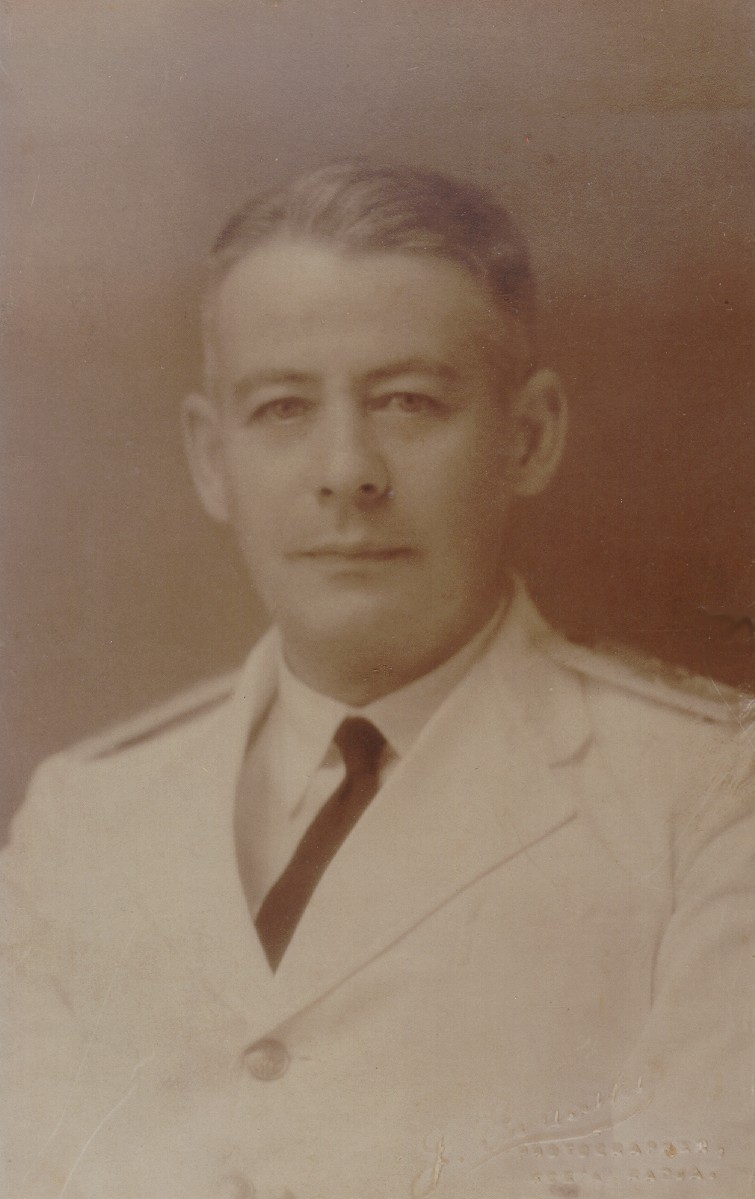
Cornelis Eduard Maier (1893-1943) was executed by firing squad in the Japanese concentration camp in Palembang, 9 November 1943
His wife, Greta Linda Maier-Goossens (1895-1945), died of dysentry in Japanese concentration camp in Lubuk Linggau, 13 August 1945
Aceh War !!
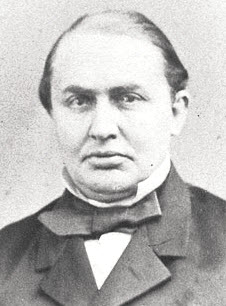
The invasion of Aceh in 1873 was the brainchild of Isaac Dignus Fransen van de Putte (1822-1902), Netherlands Minister of Colonies, to prevent encroachment by Britain into Sumatra from British colonies in Malay Peninsula

Van de Putte's idea was strongly supported by his close friend the Dutch governor-general in Batavia (now Jakarta), James Loudon (1824-1900)

Map of the defeated Dutch first invasion of Aceh in 1873, and successful second invasion in 1874

Optimistic reporting of the first Dutch invasion of Aceh in Java-Bode newspaper, 10 April 1873

Generaal-Majoor JHR Kohler, leader of first Dutch expedition to Aceh. His 2000 soldiers managed to penetrate to the Koetaradja Market and the Baiturrahman Mosque. The Dutch stopped to burn down the mosque, in which courtyard they set up a camp.
On the night of 14 April 1873, a suicidal Acehnese sneaked into the camp and shot Kohler in the chest. Kohler was killed instantly. The next days, the Dutch faced suicidal Acehnese attacks from all sides.
On 24 April 1873, they were forced to retreat back to their ships. Dutch casualties were 50 dead (including Kohler) and 500 wounded
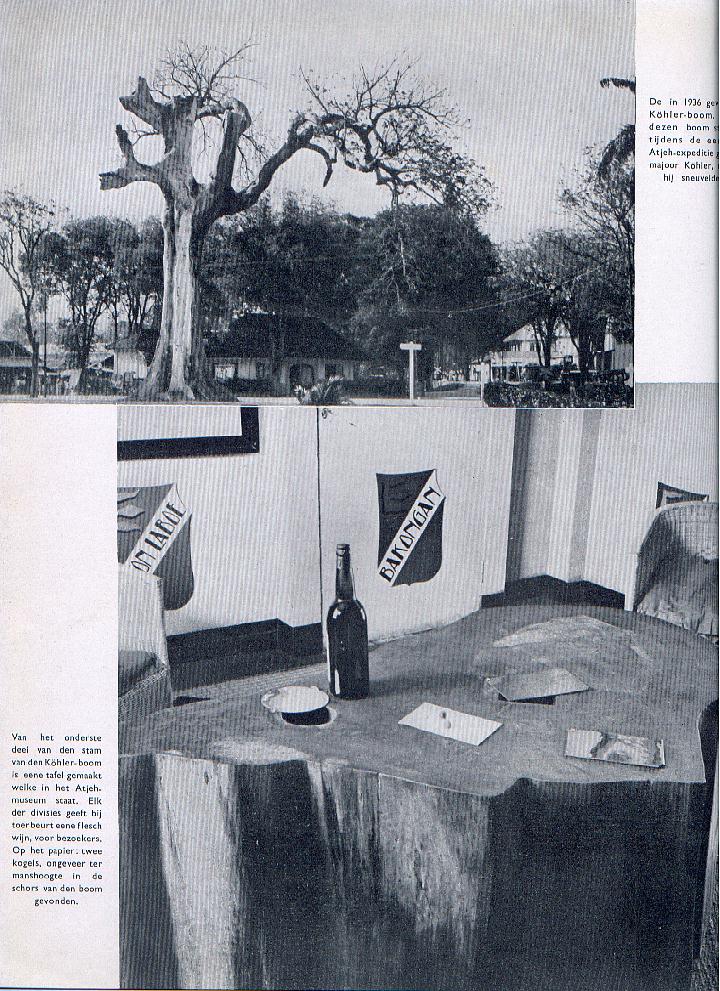
Kohler Tree, under which General Kohler was shot dead. Photograph from 1936 Dutch magazine.

Generaal Jan van Swieten (1807-1888), leader of second Dutch invasion in 1873. Swieten was an experienced soldier, fighting in Java War (1825-1830), Belgian War of Independence (1830), Padri War (1830-1837), Bali Expeditions 1848 and 1849, Bone War 1859.
The second expedition sailed with the force of 18 warships, 7 supply ships, 12 auxillary ships, 2 patrol boats, and 22 transport ships carrying more than 13,000 soldiers. Landing on 9 December 1873 some distance from Koetaradja, by 24 January 1874 had successfully occupied the capital. The three-year-old Acehnese sultan, Mohammad Daud, was taken to the jungle by his followers to continue guerilla warfare.
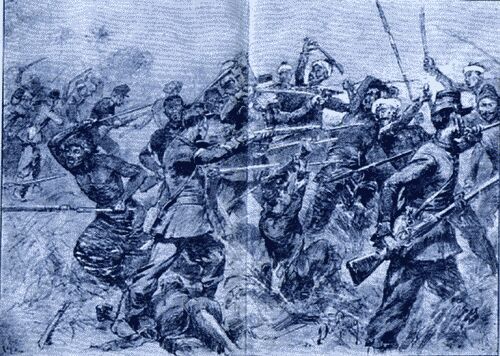
Engraving of the deadly fighting during Dutch second expedition.

After successfully occupying the royal palace, van Swieten declared victory and opened up the champagne crates to celebrate. Governor-General Loudon telegramed Minister van de Putte back in The Netherlands, informing him that "Atjeh is ons", "Aceh is ours". According to past experience, other Dutch wars of conquest in Indonesia was usually won by occupying the capital of the particular region to be conquered. This is not the case in Aceh.
After failed attempts to retake Koetaradja, by April 1874 the Acehnese settled to lay siege on the town, cutting all supplies from coming in from the interior. Road between Koetaradja and Oelee-Lhee port, where Dutch supplies came from, was unsafe due to frequent Acehnese attacks. By 1875, 25% of Dutch troops in Koetaradja had been put out of action by disease, hunger, and war wounds.

Coinciding with silver jubilee of King Willem III's coronation in 1874, Generaal van Swieten received the Militaire Willemsorde medal above for his "victory" over the Acehnese. However, by 1875, only around 0.1% of Aceh is under Dutch control, which is Koetaradja and the port of Oelee-Lhee.

The invasion of Aceh in 1873 was the brainchild of Isaac Dignus Fransen van de Putte (1822-1902), Netherlands Minister of Colonies, to prevent encroachment by Britain into Sumatra from British colonies in Malay Peninsula

Van de Putte's idea was strongly supported by his close friend the Dutch governor-general in Batavia (now Jakarta), James Loudon (1824-1900)

Map of the defeated Dutch first invasion of Aceh in 1873, and successful second invasion in 1874

Optimistic reporting of the first Dutch invasion of Aceh in Java-Bode newspaper, 10 April 1873

Generaal-Majoor JHR Kohler, leader of first Dutch expedition to Aceh. His 2000 soldiers managed to penetrate to the Koetaradja Market and the Baiturrahman Mosque. The Dutch stopped to burn down the mosque, in which courtyard they set up a camp.
On the night of 14 April 1873, a suicidal Acehnese sneaked into the camp and shot Kohler in the chest. Kohler was killed instantly. The next days, the Dutch faced suicidal Acehnese attacks from all sides.
On 24 April 1873, they were forced to retreat back to their ships. Dutch casualties were 50 dead (including Kohler) and 500 wounded

Kohler Tree, under which General Kohler was shot dead. Photograph from 1936 Dutch magazine.

Generaal Jan van Swieten (1807-1888), leader of second Dutch invasion in 1873. Swieten was an experienced soldier, fighting in Java War (1825-1830), Belgian War of Independence (1830), Padri War (1830-1837), Bali Expeditions 1848 and 1849, Bone War 1859.
The second expedition sailed with the force of 18 warships, 7 supply ships, 12 auxillary ships, 2 patrol boats, and 22 transport ships carrying more than 13,000 soldiers. Landing on 9 December 1873 some distance from Koetaradja, by 24 January 1874 had successfully occupied the capital. The three-year-old Acehnese sultan, Mohammad Daud, was taken to the jungle by his followers to continue guerilla warfare.

Engraving of the deadly fighting during Dutch second expedition.

After successfully occupying the royal palace, van Swieten declared victory and opened up the champagne crates to celebrate. Governor-General Loudon telegramed Minister van de Putte back in The Netherlands, informing him that "Atjeh is ons", "Aceh is ours". According to past experience, other Dutch wars of conquest in Indonesia was usually won by occupying the capital of the particular region to be conquered. This is not the case in Aceh.
After failed attempts to retake Koetaradja, by April 1874 the Acehnese settled to lay siege on the town, cutting all supplies from coming in from the interior. Road between Koetaradja and Oelee-Lhee port, where Dutch supplies came from, was unsafe due to frequent Acehnese attacks. By 1875, 25% of Dutch troops in Koetaradja had been put out of action by disease, hunger, and war wounds.

Coinciding with silver jubilee of King Willem III's coronation in 1874, Generaal van Swieten received the Militaire Willemsorde medal above for his "victory" over the Acehnese. However, by 1875, only around 0.1% of Aceh is under Dutch control, which is Koetaradja and the port of Oelee-Lhee.
Interesting stuff indeed. I just love your posts.
Aceh War !!

In May 1875, Generaal van Swieten, 68 years old and well-above retirement age, turned over command to Generaal-Majoor Pieter Cornelius van Pel (photo and Jakarta grave above).
Van Pel's tenure saw increasing Acehnese attacks on Dutch-held areas around Koetaradja. The Dutch lost control of Peukan Bada, Blang Kala Pass, Pagar Ajer, and Koetaradja suburbs of Moekim IX and VI. These disastrous losses caused Generaal-Majoor van Pel to be recalled. He sailed for Batavia on June 1877, replaced by one-eyed Generaal Karel van der Heyden


Generaal Karel van der Heyden (1824-1901), half-Dutch and half-Bugis general who took over command of Aceh troops in 1877. He was known as generaal een-oog (one-eyed general) by his troops and setan seblah mata (one-eyed demon) by his Acehnese opponents.
He strengthened Koetaradja's defences and secured the road between Koetaradja and Oelee-Lhee. On 29 June 1878, he launced an attack from Koetaradja, successfully capturing strategic Glitaroenpass, leading to the capture of Montasik plains, the stronghold of Acehnese guerilla leader Panglima Polim. By the end of his tenure in 1880, van der Heyden had secured tenuos Dutch control over most of Groot-Atjeh, the area surrounding Koetaradja (now Aceh Besar district).

Among the important leaders of Acehnese resistance in this early part of the war is Tengku Chik di Tiro, an Islamic cleric who led Acehnese contingent from Pidie in the fighting around Koetaradja. He declared jihad, holy war against infidel Dutch invaders who had burnt the Baiturrahman mosque, centre of Acehnese Islam. He decreed the war a perang sabil, in which Acehnese killed by the Dutch would be assured a place in paradise. In 1876, he presided over the re-coronation of the child Sultan Muhammad Daud in Indrapoeri Mosque as symbol of the continuation of Acehnese sultanate.
Militarily, he launched unsuccessful seaborne attacks on Breueh and Nasi islands off Koetaradja in 1880, attempting to disturb Dutch sea supply routes. In May 1881, he successfully assaulted the Dutch fort at Lambaro, Groot Atjeh. In 1891, an Acehnese under the pay of the Dutch killed Chik di Tiro by poisoning his food.

Habib Abdoerrachman Al-Zahir, a Turkish cleric, travelled to Turkey to gather support for Aceh from the Ottoman Empire, the chief Muslim state at the time; to Singapore where he met United States consul; and to Penang where he promised the British the island of Sabang if they would help Aceh against the Dutch.
Failing in his efforts, Habib Abdoerrachman surrendered to the Dutch at Koetaradja on July 1878, secured an annual subsidy of $500 from the Dutch government, then sailed back to Istanbul where he died in 1902.

Tjoet Nja Dhien (1850-1908), a famous female guerilla leader from Lampisang, just west of Koetaradja. She first led a unit under her father, Nanta Setia and husband, Teuku Ibrahim in the successful fighting in 1870s. In 1881 her husband was killed in a battle, whereby she married her cousin Teuku Umar, another guerilla leader.

Teuku Umar (1854-1899), leader of contingent from West Aceh in fighting around Koetaradja. His father Mahmoed is the brother of Nanta Setia, father of Tjoet Nja Dhien whom he married in 1884. After ten years as effective guerilla leader against the Dutch, Teuku Umar surrendered to the Dutch on 30 September 1893, receiving the title Teuku Djohan Pahlawan, "Lord Hero-Winner" and substantial amount of guns and ammunition to help the Dutch fight other insurgents.

Teuku Umar (sitting left), partially wearing Dutch uniform.
In 1896, Teuku Umar abandoned the Dutch, carrying off 880 rifles, 25000 bullets, 500 kg of explosives, 5000 kg of lead balls, and $18000 worth of cash back to the jungles.
This extraordinary exploit send shockwaves all the way to The Netherlands. A popular poem was sung by the Dutch:
Teuku Umar die moet hangen
Aan en touw, aan en touw
Teuku Umar en zijn vrouw
meaningTeuku Umar must be hanged
On the rope, on the rope
Teuku Umar and his wife!
Upon hearing Teuku Umar's deed, Queen Wilhelmina and Dowager Emma send a telegram to Dutch commander in Koetaradja demanding they recover the lost honour inflicted on the name of The Netherlands.
Three years later, on 11 February 1899, Teuku Umar and his 800 men was ambushed by 20 men of special Marechausse troops near Meulaboh, West Aceh. Umar was shot in the chest and died days later in front of his wife, Tjoet Nja Dhien.

Dutch memorial on the site of Teuku Umar's fall on February 1899

Tjoet Nja Dhien and Pang Laot after her capture.
Tjoet Nja Dhien continued guerilla warfare in West Aceh area, assited by Pang Laot. Years of living in the jungle caused her to go blind and she also suffered rheumatism, yet she refused to surrender. On 16 October 1905, Pang Laot, unable to let Tjoet Nja Dhien suffered anymore, led a Dutch Marechausse squad under Luitenant Van Vuuren to her hideout. She was arrested and exiled to West Java, where she died in 1908.

In May 1875, Generaal van Swieten, 68 years old and well-above retirement age, turned over command to Generaal-Majoor Pieter Cornelius van Pel (photo and Jakarta grave above).
Van Pel's tenure saw increasing Acehnese attacks on Dutch-held areas around Koetaradja. The Dutch lost control of Peukan Bada, Blang Kala Pass, Pagar Ajer, and Koetaradja suburbs of Moekim IX and VI. These disastrous losses caused Generaal-Majoor van Pel to be recalled. He sailed for Batavia on June 1877, replaced by one-eyed Generaal Karel van der Heyden


Generaal Karel van der Heyden (1824-1901), half-Dutch and half-Bugis general who took over command of Aceh troops in 1877. He was known as generaal een-oog (one-eyed general) by his troops and setan seblah mata (one-eyed demon) by his Acehnese opponents.
He strengthened Koetaradja's defences and secured the road between Koetaradja and Oelee-Lhee. On 29 June 1878, he launced an attack from Koetaradja, successfully capturing strategic Glitaroenpass, leading to the capture of Montasik plains, the stronghold of Acehnese guerilla leader Panglima Polim. By the end of his tenure in 1880, van der Heyden had secured tenuos Dutch control over most of Groot-Atjeh, the area surrounding Koetaradja (now Aceh Besar district).

Among the important leaders of Acehnese resistance in this early part of the war is Tengku Chik di Tiro, an Islamic cleric who led Acehnese contingent from Pidie in the fighting around Koetaradja. He declared jihad, holy war against infidel Dutch invaders who had burnt the Baiturrahman mosque, centre of Acehnese Islam. He decreed the war a perang sabil, in which Acehnese killed by the Dutch would be assured a place in paradise. In 1876, he presided over the re-coronation of the child Sultan Muhammad Daud in Indrapoeri Mosque as symbol of the continuation of Acehnese sultanate.
Militarily, he launched unsuccessful seaborne attacks on Breueh and Nasi islands off Koetaradja in 1880, attempting to disturb Dutch sea supply routes. In May 1881, he successfully assaulted the Dutch fort at Lambaro, Groot Atjeh. In 1891, an Acehnese under the pay of the Dutch killed Chik di Tiro by poisoning his food.

Habib Abdoerrachman Al-Zahir, a Turkish cleric, travelled to Turkey to gather support for Aceh from the Ottoman Empire, the chief Muslim state at the time; to Singapore where he met United States consul; and to Penang where he promised the British the island of Sabang if they would help Aceh against the Dutch.
Failing in his efforts, Habib Abdoerrachman surrendered to the Dutch at Koetaradja on July 1878, secured an annual subsidy of $500 from the Dutch government, then sailed back to Istanbul where he died in 1902.

Tjoet Nja Dhien (1850-1908), a famous female guerilla leader from Lampisang, just west of Koetaradja. She first led a unit under her father, Nanta Setia and husband, Teuku Ibrahim in the successful fighting in 1870s. In 1881 her husband was killed in a battle, whereby she married her cousin Teuku Umar, another guerilla leader.

Teuku Umar (1854-1899), leader of contingent from West Aceh in fighting around Koetaradja. His father Mahmoed is the brother of Nanta Setia, father of Tjoet Nja Dhien whom he married in 1884. After ten years as effective guerilla leader against the Dutch, Teuku Umar surrendered to the Dutch on 30 September 1893, receiving the title Teuku Djohan Pahlawan, "Lord Hero-Winner" and substantial amount of guns and ammunition to help the Dutch fight other insurgents.

Teuku Umar (sitting left), partially wearing Dutch uniform.
In 1896, Teuku Umar abandoned the Dutch, carrying off 880 rifles, 25000 bullets, 500 kg of explosives, 5000 kg of lead balls, and $18000 worth of cash back to the jungles.
This extraordinary exploit send shockwaves all the way to The Netherlands. A popular poem was sung by the Dutch:
Teuku Umar die moet hangen
Aan en touw, aan en touw
Teuku Umar en zijn vrouw
meaningTeuku Umar must be hanged
On the rope, on the rope
Teuku Umar and his wife!
Upon hearing Teuku Umar's deed, Queen Wilhelmina and Dowager Emma send a telegram to Dutch commander in Koetaradja demanding they recover the lost honour inflicted on the name of The Netherlands.
Three years later, on 11 February 1899, Teuku Umar and his 800 men was ambushed by 20 men of special Marechausse troops near Meulaboh, West Aceh. Umar was shot in the chest and died days later in front of his wife, Tjoet Nja Dhien.

Dutch memorial on the site of Teuku Umar's fall on February 1899

Tjoet Nja Dhien and Pang Laot after her capture.
Tjoet Nja Dhien continued guerilla warfare in West Aceh area, assited by Pang Laot. Years of living in the jungle caused her to go blind and she also suffered rheumatism, yet she refused to surrender. On 16 October 1905, Pang Laot, unable to let Tjoet Nja Dhien suffered anymore, led a Dutch Marechausse squad under Luitenant Van Vuuren to her hideout. She was arrested and exiled to West Java, where she died in 1908.
Aceh War !!
After 30 years of endless warfare without prospect of winning, Acehnese guerilla leaders started to surrender. On 5 January 1903, Sultan Mohammad Daoed, now 33 years old, surrendered in Sigli after living in the jungle for 30 years!

Sultan Mohammad Daoed swore oath of loyalty to the portrait of Queen Wilhelmina in Atjeh governor's office on February 1903.

Sultan Mohammad Daoed on January 1903 after his surrender in Sigli, Pidie. He abdicate from the throne, and acknowledged the suzerainity of Queen Wilhelmina over his former sultanate of Atjeh. He spend his days under Dutch house-arrest in Koetaradja and died there in 1928.
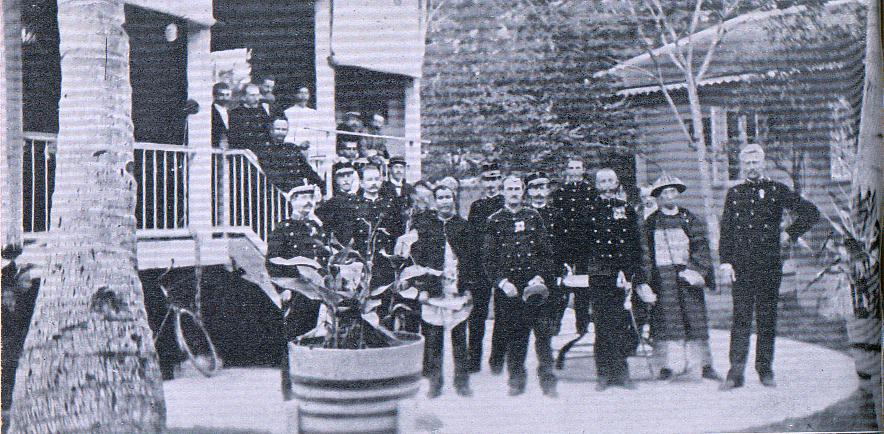
Panglima Polim Sri Moeda Perkasa Shah (centre), who had fought the Dutch in Koetaradja since 1873 and was a guerilla leader in Lhokseumawe area, surrendered to the Dutch Kapitein Hendricus Colijn (third from right) in Lhokseumawe in 6 September 1903, together with 150 of his men. He was given the post raja of Sigli by the Dutch. In 1928, Panglima Polim received the cross of Nassau-Oranje Orde

Old Panglima Polim, raja of Sigli, wearing medal of The House of Orange in 1938, one year before his death.
The Dutch Point of View
Throughout the 1880s, Dutch control over Aceh is limited in Koetaradja and its surrounds, while cooperative local rulers allowed the Dutch footholds in Idi, Langsa, Lhokseumawe, Meulaboh, Tapaktuan, and Trumon. The Dutch were unable to contol the rural areas due to its unfamiliarity to guerilla warfare.

To protect Koetaradja from constant Acehnese raids, Generaal van der Heyden decided to establish a line of 16 forts linked with barbed wire, telephone and telegraph lines, and a tramline. This fortification system is called the concentration line (geconcentreerde linie) and was finished in 1884.
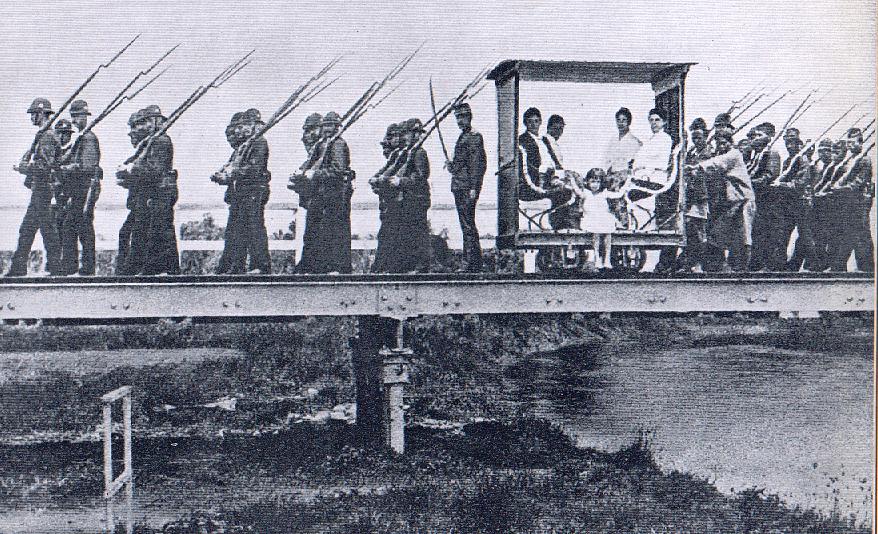
Dutch family on the concentration line tramline, 1880s
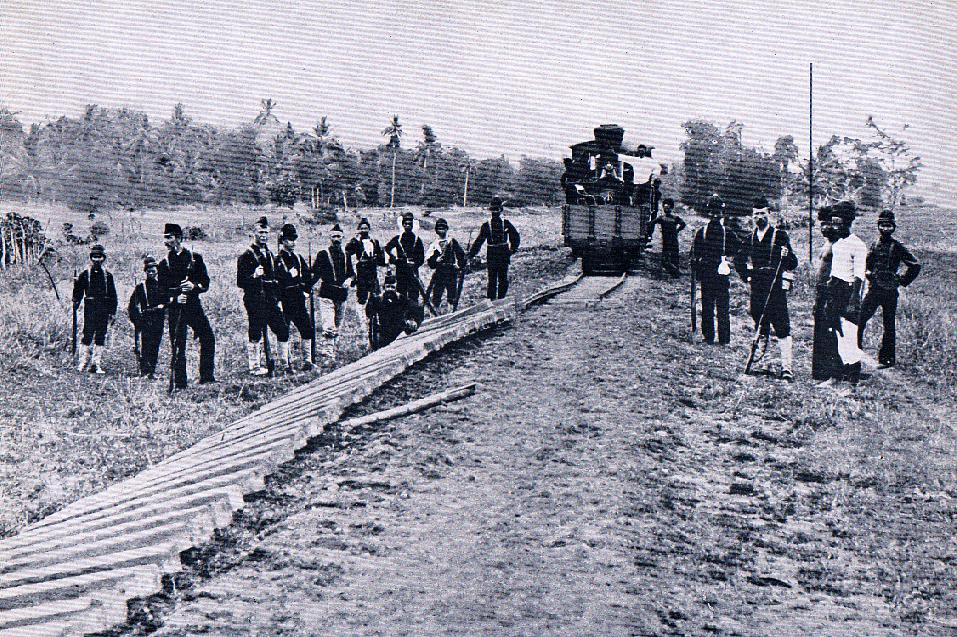
Damaged tramcar line after Acehnese attack, 1890s


Unable to defeat the Acehnese militarily, the Dutch tried a cultural approach. They asked the advice of Christiaan Snouck Hurgronje (1857-1933), an expert on Islam who had visited Mecca in 1884 posing as an Arab. His advice was basically to woo the Acehnese nobility (uleebalang) and crush the remaining resistance mercilessly.
After 30 years of endless warfare without prospect of winning, Acehnese guerilla leaders started to surrender. On 5 January 1903, Sultan Mohammad Daoed, now 33 years old, surrendered in Sigli after living in the jungle for 30 years!

Sultan Mohammad Daoed swore oath of loyalty to the portrait of Queen Wilhelmina in Atjeh governor's office on February 1903.

Sultan Mohammad Daoed on January 1903 after his surrender in Sigli, Pidie. He abdicate from the throne, and acknowledged the suzerainity of Queen Wilhelmina over his former sultanate of Atjeh. He spend his days under Dutch house-arrest in Koetaradja and died there in 1928.

Panglima Polim Sri Moeda Perkasa Shah (centre), who had fought the Dutch in Koetaradja since 1873 and was a guerilla leader in Lhokseumawe area, surrendered to the Dutch Kapitein Hendricus Colijn (third from right) in Lhokseumawe in 6 September 1903, together with 150 of his men. He was given the post raja of Sigli by the Dutch. In 1928, Panglima Polim received the cross of Nassau-Oranje Orde

Old Panglima Polim, raja of Sigli, wearing medal of The House of Orange in 1938, one year before his death.
The Dutch Point of View
Throughout the 1880s, Dutch control over Aceh is limited in Koetaradja and its surrounds, while cooperative local rulers allowed the Dutch footholds in Idi, Langsa, Lhokseumawe, Meulaboh, Tapaktuan, and Trumon. The Dutch were unable to contol the rural areas due to its unfamiliarity to guerilla warfare.

To protect Koetaradja from constant Acehnese raids, Generaal van der Heyden decided to establish a line of 16 forts linked with barbed wire, telephone and telegraph lines, and a tramline. This fortification system is called the concentration line (geconcentreerde linie) and was finished in 1884.

Dutch family on the concentration line tramline, 1880s

Damaged tramcar line after Acehnese attack, 1890s

Unable to defeat the Acehnese militarily, the Dutch tried a cultural approach. They asked the advice of Christiaan Snouck Hurgronje (1857-1933), an expert on Islam who had visited Mecca in 1884 posing as an Arab. His advice was basically to woo the Acehnese nobility (uleebalang) and crush the remaining resistance mercilessly.
Aceh War !!

In accordance the advice of Snouck Hurgronje, a Dutch officer named Koloneel, later Generaal Johannes Benedictus van Heutsz (1851-1924) came up with the idea of highly mobile and independent units capable of fighting the Acehnese insurgents deep in the jungles, at the home of the guerillas themselves.

The idea was realised in 1896 with the establishment of Korps Marechausse. Each of its units consisted of 20 native soldiers (due to their natural ability to live in the jungle) led by a Dutch officer and an Ambonese corporal. Each soldier was armed with the new M95 self-loading rifle and a klewang, a native sword. Their motto was "Berani soempah!" (Dare to swear!)

First commander of the Korps Marechausse, Kapitein Jonkheer GJWCH Graafland

Ceremonial uniform of the Korps Marechausse, worn by a Luitenant Geldorp

The regimental banner of the Korps Marechausse

Generaal van Heutsz (centre) watching the assault on Acehnese fortress Batee Iliek in Tiro, Pidie on 3 February 1901. To his right were Kolonel van Dussen, Majoor Doorman, Kapitein Spruijt, Luitenant Schutstal van Woudenberg, and controleur Frijling. The defeated Acehnese lost 71 men, the Dutch lost 5 killed and 37 wounded.

Van Heutsz was military governor of Aceh fron 1898-1904. He became governor-general of the Netherlands East Indies from 1904-1909. He later returned to Europe and died in Montreux in 1924. Above picture was the Van Heutsz Memorial in Koetaradja in 1932.

Van Heutsz Monument in Batavia (Jakarta), demolished in 1945

Van Heutsz Monument in Vijzelstraat 32 Amsterdam. His son, Johannes Benedictus van Heutsz Jr joined the German army during World War II, reaching the rank SS-Sturmbahnfuhrer der Waffen-SS, and was killed in Russia in 1943.
Van Heutsz is credited as the first person in history to unite the Indonesian Archipelago under one political unit. In his Amsterdam Monument, the epitaph was written:
JB VAN HEUTSZ
GOUVERNEUR-GENERAAL VAN NEDERLANDS-INDIE
1904 TOT 1909
HIJ SCHIEP ORDE, RUST, EN WELVAART
EN HEEFT DE VOLKEN VAN NEDERLANDS-INDIE
TOT EEN EENHEID GESMEED
meaningJB VAN HEUTSZ
GOVERNOR-GENERAL OF NETHERLANDS INDIES
1904 TO 1909
HE SHAPED ORDER, PEACE, AND WELFARE
AND GUIDE THE PEOPLE OF NETHERLANDS INDIES
TOWARDS THE GATE OF UNITY
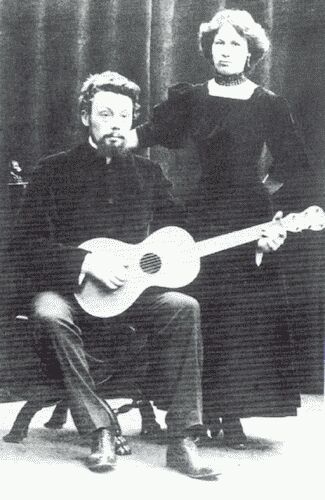
Koos Speenhoff and Caesarina Speenhoff-Prinz (1907), anti-war folk singers who specialised in slamming the bloody Dutch war in Aceh.

In accordance the advice of Snouck Hurgronje, a Dutch officer named Koloneel, later Generaal Johannes Benedictus van Heutsz (1851-1924) came up with the idea of highly mobile and independent units capable of fighting the Acehnese insurgents deep in the jungles, at the home of the guerillas themselves.

The idea was realised in 1896 with the establishment of Korps Marechausse. Each of its units consisted of 20 native soldiers (due to their natural ability to live in the jungle) led by a Dutch officer and an Ambonese corporal. Each soldier was armed with the new M95 self-loading rifle and a klewang, a native sword. Their motto was "Berani soempah!" (Dare to swear!)

First commander of the Korps Marechausse, Kapitein Jonkheer GJWCH Graafland

Ceremonial uniform of the Korps Marechausse, worn by a Luitenant Geldorp

The regimental banner of the Korps Marechausse

Generaal van Heutsz (centre) watching the assault on Acehnese fortress Batee Iliek in Tiro, Pidie on 3 February 1901. To his right were Kolonel van Dussen, Majoor Doorman, Kapitein Spruijt, Luitenant Schutstal van Woudenberg, and controleur Frijling. The defeated Acehnese lost 71 men, the Dutch lost 5 killed and 37 wounded.

Van Heutsz was military governor of Aceh fron 1898-1904. He became governor-general of the Netherlands East Indies from 1904-1909. He later returned to Europe and died in Montreux in 1924. Above picture was the Van Heutsz Memorial in Koetaradja in 1932.

Van Heutsz Monument in Batavia (Jakarta), demolished in 1945

Van Heutsz Monument in Vijzelstraat 32 Amsterdam. His son, Johannes Benedictus van Heutsz Jr joined the German army during World War II, reaching the rank SS-Sturmbahnfuhrer der Waffen-SS, and was killed in Russia in 1943.
Van Heutsz is credited as the first person in history to unite the Indonesian Archipelago under one political unit. In his Amsterdam Monument, the epitaph was written:
JB VAN HEUTSZ
GOUVERNEUR-GENERAAL VAN NEDERLANDS-INDIE
1904 TOT 1909
HIJ SCHIEP ORDE, RUST, EN WELVAART
EN HEEFT DE VOLKEN VAN NEDERLANDS-INDIE
TOT EEN EENHEID GESMEED
meaningJB VAN HEUTSZ
GOVERNOR-GENERAL OF NETHERLANDS INDIES
1904 TO 1909
HE SHAPED ORDER, PEACE, AND WELFARE
AND GUIDE THE PEOPLE OF NETHERLANDS INDIES
TOWARDS THE GATE OF UNITY

Koos Speenhoff and Caesarina Speenhoff-Prinz (1907), anti-war folk singers who specialised in slamming the bloody Dutch war in Aceh.
Aceh War !!
Other Dutch generals:

Luitenant-Kolonel HNA Swart (1857-1922), ruthlessly eliminated Acehnese guerillas in Lhokseumawe-Bireuen area, govenor of Atjeh 1908-1912, vice-president of Raad van Indie (Indies Council advising the governor-general) in Batavia till his death in 1922. His governorship on Aceh saw the last guerilla bands destroyed by Marechausse troops, hence he was known as "pacifier of Aceh".

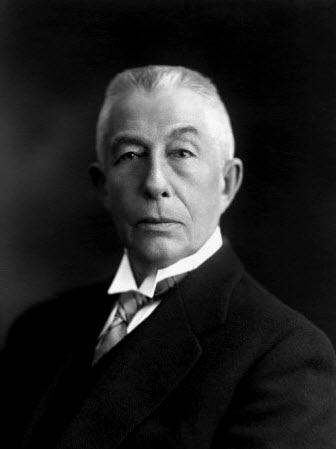
Luitenant Hendrikus Colijn (1869-1944), adjudant to van Heutsz, the person receiving surrender of Panglima Polim, later Prime Minister of The Netherlands (1925-1926; 1933-1939). Colijn died under German custody in 1944.

Kapitein Heinz Christoffel, organised Tijger Colonne that devastate the Panton Laboe and Pidie areas, destroying the guerilla's base there. He received the Militaire Willemsorde and later led the Dutch "pacification" of Flores, Buton, and East Borneo in 1907-1912.

Christoffel leading a Tijger Colonne in Aceh

Kolonel Gotfried Coenraad Ernst van Daalen (1863-1930), Dutch colonel who devastate the Gayo-Alas area from February-July 1904, subjugating the highland tribes under Dutch rule. His method was known as van-daal-isme (van-daal-ism).

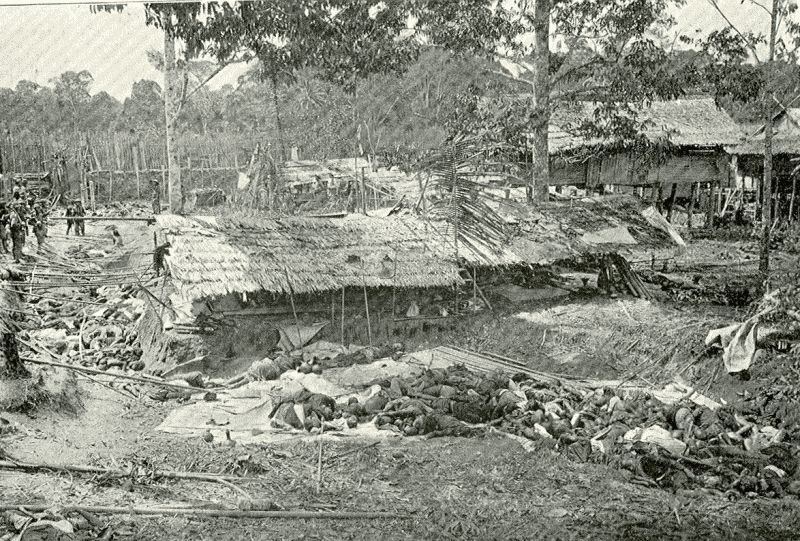
Remnants of Koeta Reh village in Gayo Highlands after a vist by van Daalen
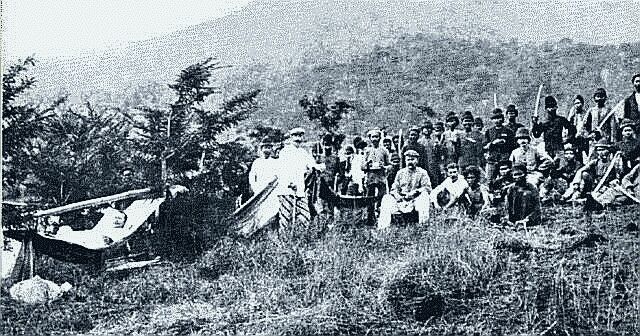
Van Daalen resting on the hanging cot while leading a patrol into Gayo Highlands in 1904

Men of Korps Marechausse posing after a sucessful operation.
Other Dutch generals:

Luitenant-Kolonel HNA Swart (1857-1922), ruthlessly eliminated Acehnese guerillas in Lhokseumawe-Bireuen area, govenor of Atjeh 1908-1912, vice-president of Raad van Indie (Indies Council advising the governor-general) in Batavia till his death in 1922. His governorship on Aceh saw the last guerilla bands destroyed by Marechausse troops, hence he was known as "pacifier of Aceh".


Luitenant Hendrikus Colijn (1869-1944), adjudant to van Heutsz, the person receiving surrender of Panglima Polim, later Prime Minister of The Netherlands (1925-1926; 1933-1939). Colijn died under German custody in 1944.

Kapitein Heinz Christoffel, organised Tijger Colonne that devastate the Panton Laboe and Pidie areas, destroying the guerilla's base there. He received the Militaire Willemsorde and later led the Dutch "pacification" of Flores, Buton, and East Borneo in 1907-1912.

Christoffel leading a Tijger Colonne in Aceh

Kolonel Gotfried Coenraad Ernst van Daalen (1863-1930), Dutch colonel who devastate the Gayo-Alas area from February-July 1904, subjugating the highland tribes under Dutch rule. His method was known as van-daal-isme (van-daal-ism).


Remnants of Koeta Reh village in Gayo Highlands after a vist by van Daalen

Van Daalen resting on the hanging cot while leading a patrol into Gayo Highlands in 1904

Men of Korps Marechausse posing after a sucessful operation.
Aceh War !!

Korps Marechausse men in their egelstelling "porcupine formation" in Aceh.

Captured Acehnese guerillas.

Medals given to veterans of Aceh War in 1870s, bearing the likeness of Dutch king Willem III, father of future Queen Wilhelmina

A Surabaya restaurant 1902 menu celebrated recent Dutch victories over Indonesians in Aceh and elsewhere in the archipelago by naming its dishes after vanquished Indonesian cities

Aceh War veterans reunion in 1938.

Toekoe Oemar Spel, a popular children's game in 1890s Netherlands involving 25 white figurines (Dutch soldiers) chasing one black figure (Teuku Umar)!

Dutch anti-war cartoon from 1900 ridiculing the awarding of Militaire Willemsorde to "bloodhounds".

Another cartoon depicting Dutch missionaries spreading the Bible to "pacified" natives.
Click here for detailed history of Aceh War and other events in Netherlands Indies

Korps Marechausse men in their egelstelling "porcupine formation" in Aceh.

Captured Acehnese guerillas.

Medals given to veterans of Aceh War in 1870s, bearing the likeness of Dutch king Willem III, father of future Queen Wilhelmina

A Surabaya restaurant 1902 menu celebrated recent Dutch victories over Indonesians in Aceh and elsewhere in the archipelago by naming its dishes after vanquished Indonesian cities

Aceh War veterans reunion in 1938.

Toekoe Oemar Spel, a popular children's game in 1890s Netherlands involving 25 white figurines (Dutch soldiers) chasing one black figure (Teuku Umar)!

Dutch anti-war cartoon from 1900 ridiculing the awarding of Militaire Willemsorde to "bloodhounds".

Another cartoon depicting Dutch missionaries spreading the Bible to "pacified" natives.
Click here for detailed history of Aceh War and other events in Netherlands Indies
That fu-king dutch troop did genocide to Achehnese Gayo civillian. 
The way they won the war by killing all civillian related to Achehnese warrior.
I heard/read somewhere most this barbaric act done by fanatic Cristian Ambonese soldier and some of them also Javanse soldier which Indonesian who fought against dutch called them at that time "black dutch" since Ambonese is black/dark skin typical melanesian. They are more cruel than dutch itself.
The way they won the war by killing all civillian related to Achehnese warrior.
I heard/read somewhere most this barbaric act done by fanatic Cristian Ambonese soldier and some of them also Javanse soldier which Indonesian who fought against dutch called them at that time "black dutch" since Ambonese is black/dark skin typical melanesian. They are more cruel than dutch itself.
| QUOTE (purnomor @ Aug 31 2004, 07:15 PM) |
  Remnants of Koeta Reh village in Gayo Highlands after a vist by van Daalen |
Bandung, West Java

The first buildings of Technische Hogeschoole te Bandoeng (THB), now the Institut Tekhnologi Bandung (ITB) when it was opened in 1920. First president Soekarno would later enrolled in the THB in 1924.

Alun-alun (Town Square) and Grand Mosque area in Bandung

Pasteurstraat, showing the current Biofarma building

Bragastraat, the main shopping avenue of Dutch Bandoeng

European residential area

A street in European residential area

Bethel Church, built 1926

Aerial photograph of northern Bandoeng

Welcoming Queen Wilhelmina in Alun-alun area
Black-and-white film of Bandoeng in 1930 and 1912
Black-and-white film of Batavia (Jakarta) in 1919

The first buildings of Technische Hogeschoole te Bandoeng (THB), now the Institut Tekhnologi Bandung (ITB) when it was opened in 1920. First president Soekarno would later enrolled in the THB in 1924.

Alun-alun (Town Square) and Grand Mosque area in Bandung

Pasteurstraat, showing the current Biofarma building

Bragastraat, the main shopping avenue of Dutch Bandoeng

European residential area

A street in European residential area

Bethel Church, built 1926

Aerial photograph of northern Bandoeng

Welcoming Queen Wilhelmina in Alun-alun area
Black-and-white film of Bandoeng in 1930 and 1912
Black-and-white film of Batavia (Jakarta) in 1919
ohh Bandung, my sweet hometown, it's much more crowded and hectic but I still love my Bandung. Can't help to wonder if only we had a better city planning and not destroy some of the beautiful heritage buildings- but it's quite heart-warming too to see that some of buildings from the movie clip still look exactly the same. Oh and Purnomor, you just posted my grandfather's old house under "European residential area". The row of houses on top of the stonewalls, it is Jalan Wastukencana and my grandfather's house is on the right. He sold the house in the 80's when my grandmother passed away.
Civic Heraldry from the Dutch colonial era city authorities

Civic seal of Amboina (Ambon), Maluku

Civic seal of Bandoeng, West Java

Civic seal of Batavia (Jakarta)

Civic seal of Buitenzorg (Bogor), West Java

Civic seal of Tjeribon, West Java

Civic seal of Madioen, East Java

Civic seal of Makassar, South Celebes

Civic seal of Medan, North Sumatera

Civic seal of Malang, East Java

Civic seal of Padang, West Sumatera

Civic seal of Amboina (Ambon), Maluku

Civic seal of Bandoeng, West Java

Civic seal of Batavia (Jakarta)

Civic seal of Buitenzorg (Bogor), West Java

Civic seal of Tjeribon, West Java

Civic seal of Madioen, East Java

Civic seal of Makassar, South Celebes

Civic seal of Medan, North Sumatera

Civic seal of Malang, East Java

Civic seal of Padang, West Sumatera

Civic seal of Pekalongan, Central Java

Civic seal of Semarang, Central Java

Civic seal of Tegal, Central Java

Civic seal of Tjiandjoer, West Java

Coat-of-arms of Netherlands East Indies, same with coat-of-arms of The Netherlands
International Civic Heraldry Website
some of the pics here looks like the old manila before ww2 when the japanese f'ed it up bad. the rape of manila and the battle of manila really made manila so f'ed up it never recovered. but yeah nice pics really nice. many of them structures still up or what.
^ yeap, most of 'em still standing
| QUOTE (purnomor @ Aug 31 2004, 07:56 PM) |
 Another cartoon depicting Dutch missionaries spreading the Bible to "pacified" natives. |
very informative! may i know where you got your pictures from? thx!
ReplyDeleteAny Indonesians who supported the Dutch terrorists are the traitors because they helped the Dutch to attack and occupy Indonesia and oppress and kill Indonesians throughout history. The traitors and their descendants must follow the Dutch terrorists back to Netherland. The people of Aceh had proven that Dutch can be defeated if there were no traitors ! It is better to die as an Acehnese fighter rather than dying as a Dutch dog ! Long live Indonesia.
ReplyDeleteTranslation:
Setiap orang Indonesia yang mendukung teroris Belanda adalah pengkhianat karena mereka membantu Belanda untuk menyerang dan menduduki Indonesia dan menindas dan membunuh orang Indonesia sepanjang sejarah. Para pengkhianat dan keturunan mereka harus mengikuti teroris Belanda kembali ke Belanda. Masyarakat Aceh telah membuktikan bahwa Belanda dapat dikalahkan jika tidak ada pengkhianat! Lebih baik mati sebagai pejuang Aceh daripada mati sebagai anjing Belanda! Hidup Indonesia !
Lah? Kenapa Aceh gak sekalian merdeka aja dari Indonesia?
DeleteThis comment has been removed by the author.
ReplyDelete